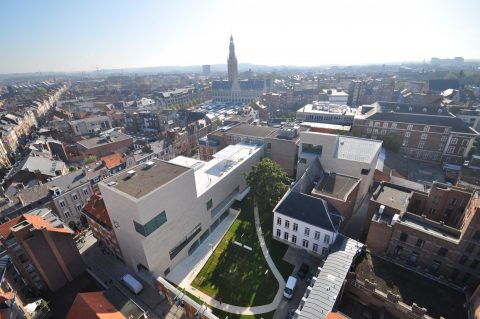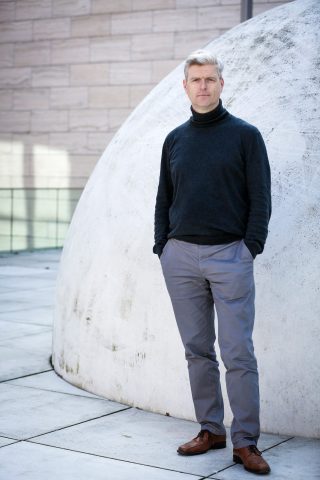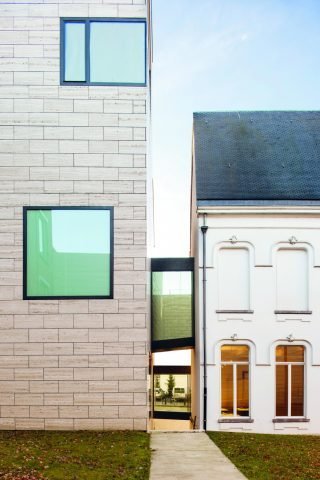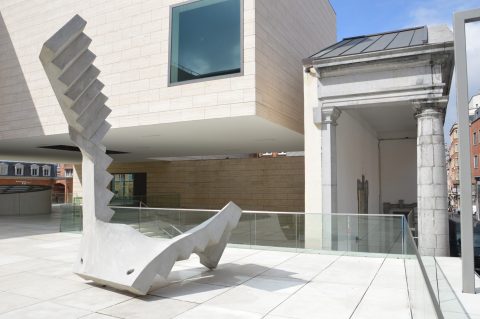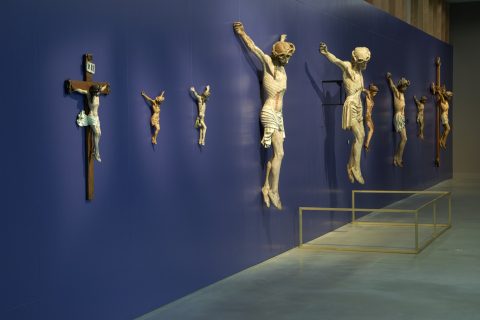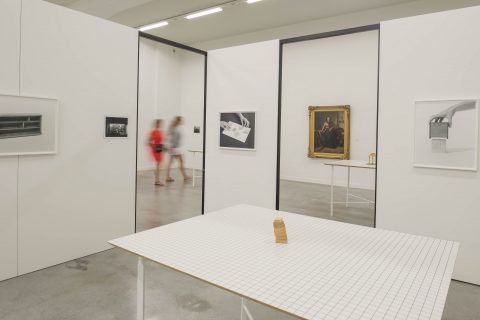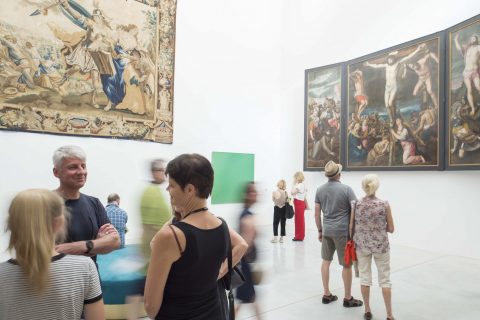Will the future of historical art museums look like this?
The recently revamped M Museum Leuven is now one of the most innovative displays of a historical collection in Europe. We spoke with director Peter Bary to understand M’s new museum strategy and whether the coexistence with contemporary art in the same institution played a role in it.
- M Museum Leuven
- Peter Bary, director of M Museum Leuven, ph. Rob Stevens.
- M Museum Leuven, ph. Larsen Heleen.
- M Museum Leuven, ph. Veerle Ausloos.
- M Museum Leuven, Collection presentation ‘Masters of sculpture’, ph. Dirk Pauwels
- M Museum Leuven, ph. Rudi Van Beek.
- M Museum Leuven, ph. Rudi Van Beek.
M Museum Leuven is one recent example of a European art museum successfully responding to the problem of reshaping a historical collection to appeal to a changing society. If in the past some of the unquestioned purposes of a museum were to please audiences with aesthetically relevant objects and display a certain cultural heritage, a more fragmented ecology of visitors, which implies fragmented aesthetic sensibilities and different interests in heritage, has required European museums to question themselves. M Museum Leuven is one such case, and in the interview that follows director Peter Bary explains the strategy the museum has followed in attempting to change itself through a recently completed renovation, also keeping its nature of internationally renowned space for contemporary art—a reputation also confirmed by the fact the M’s contemporary art curator Eva Wittockx is also the mind behind this year’s Belgian pavilion at the Venice Biennale. From the interview, we learn that some of the keys for this successful change were a specific focus on the visitor experience and an interesting “departure from the object”.
Across Belgium there are exceptional museums for contemporary art and exceptional museums for old masters. However, M Museum Leuven is one of the few museums in the country that hosts both contemporary and historical art under the same roof. What are the advantages and disadvantages of this specific situation?
It is indeed true that M Museum Leuven is characterized by a trans-historical approach. Concretely, we combine the presentation of a historical collection with exhibitions by both upcoming and established contemporary artists in the international artistic scene. We are thus partly a time capsule and partly a platform for the presentation of contemporary art.
Allow me to give you a very concrete example: M Museum Leuven is currently showing an extensive retrospective of the oeuvre of French artist Aurélien Froment, as well as a presentation that reflects on the life and philosophy of the German educational scientist Friedrich Fröbel. Froment has placed numerous cubes, globes, and cylinders throughout the space. These are the basic shapes that recur in Fröbel’s methodology, but Froment has used them in different ways. He found points of convergence in the historical works in M Museum Leuven’s collection in which these same basic shapes occur. This creates echoes across time and allows people to place objects and ideas on a continuum. It thus becomes more than a mere “museum trick”. As a museum curator, I attach great importance to what the American author and philosopher Robert Grudin once said: “We usually fail to understand that the present achieves full reality only when seen by those who retain the perspectives of past and future, that indeed no aspect of time is really available to us except in terms of the continuum”.
Leuven is a rather small town compared to nearby cities such as Brussels and Antwerp. Yet it hosts the biggest university in the country by number of students, which is also reputed to be one of the best in Europe. What is the extent of the collaboration between M and the University of Leuven and what does this collaboration involve?
What a coincidence: this question comes right after a meeting with the new vice-rector for culture and heritage at KU Leuven… The museum and the University of Leuven are of course separate and autonomous entities, but we are very friendly neighbours and we spend a lot of time together. The most intense collaboration is the co-organization of a citywide cultural festival every two or three years. The City of Leuven, the museum and the University of Leuven join forces to organize and coordinate activities and events across the city, on themes that are closely linked with Leuven as a historic centre of knowledge. The most manifestation of this collaboration was the project “The Future Is More” in late 2016. Thomas More’s book “Utopia”, which was first printed in Leuven 500 years ago, inspired an extraordinary exhibition at M Museum Leuven and a parallel exhibition at the Central University Library. Visitors were immersed in the arts and sciences of the 15th and 16th centuries, with works by Quinten Metsys, Jan Gossaert, Albrecht Dürer and Hans Holbein that had never been exhibited together before. Each work exudes the desire for the unknown and dreams of an ideal world. The museum and university were jointly responsible for the content and organization of the exhibition, while the city organized the rest of the festival, with concerts and events across Leuven.
Our synergy with KU Leuven is not limited to these ambitious co-productions, however. For example, as part of our renewed collection displays, a unique experiment took place last June, as a result of which our visitors can now explore their own visual DNA. This high-tech project, which we run with the Laboratory of Experimental Psychology directed by Professor Johan Wagemans, is part of our larger projects on “visual literacy”, which we coordinate as a museum and centre for the arts.
The recent re-design of M Museum Leuven spans different aspects of the display of the collection. Among others, new artworks are on view, there is no longer a strict chronological order, new wall labels and technological devices make the experience more interactive, and new sections have been added to the visit path. Could you please tell us how this re-design was thought through and what prompted it? What did you aim to achieve with it?
The previous collection displays, which had not changed since we first opened in 2009, were arranged according to an art-historical approach and were aesthetically a tremendous success. Based on an extensive SWOT analysis, however, we reached the conclusion that important aspects of our mission and vision were not being showcased sufficiently. We therefore opted to reorganize the collection in a dynamic presentation that is not based purely on art-historical criteria, but rather on the concept of a laboratory that focuses primarily on the visitors and experience. The arrangement of the collection is now conceived as an exhibition as such, with far greater flexibility in the exhibited pieces, and it is now structured around thematic clusters. This gives us many more possibilities to expand our scientific research and to make the visitors’ experiences much more varied.
Our new arrangement is no longer based on the perspective of the “object”, but focuses instead on the visitors, and not only in terms of their experiences but also their knowledge and what they might contribute to the community. The meaning of an artwork is generated in the confrontation of the object with a viewer. It is the viewer who imbues an object with meaning or significance by associating it with his or her own frame of reference. In this respect, the museum can and must learn from its visitors. I find that a very liberating thought.
The crucial aspect of this entire endeavour is the concept of “visual literacy”. At M Museum Leuven, the question ‘How do I read an image?’ is the key to a museum visit. Visual literacy is about acquiring the necessary skills to be resilient to and deal creatively with the ubiquitous flood of images in our society. Obviously, our new focus on visual literacy is not an impulsive change. It is the result of a four-year project in which we cooperated with experts from across the world. We participated in various sessions with the ENViL group (European Network for Visual Literacy) and for our application of the theory in the museum context we consulted the experts at the IVLA (International Visual Literacy Association) and experts at the Toledo Museum of Art in the USA. We ultimately developed a new museum model at M in which artists and curators no longer ‘give’ meaning to visitors, but in which the museum becomes a space where visitors can create their own range of meanings.
An aspect in your current display we found interesting and quite rare to come across in today’s museums is a certain stress on what scholars A.W. Eaton and Ivan Gaskell call the “representational” (Young et al., eds. 2009). By this, they mean a situation in which artworks are not presented in museums as objects for aesthetic pleasure, but rather as means to inform the audience about particular characteristics of the society that produced them. For example, all the artworks in the room “Art of Collecting” are there to show how a public collection comes to be rather than impressing for their aesthetic qualities. And even when the aesthetic qualities of an artwork are important like in the room with late-Gothic sculptures of Jesus Christ, the comparison between all these sculptures in the room serves to educate the audience about recent techniques of artwork attribution. Would you agree with this analysis? And if so, why do you think it’s important today to move away from an aestheticized display of artwork?
The organization of “Art of Collecting” is based on the almost anthropological fact that everyone collects something. For example, you may well collect photos on your smartphone. Various local collectors present their treasures and – importantly – explain their motivations in a video clip. This exhibition contains an important democratic appeal. The “institution” M Museum Leuven has something essential in common with you as a visitor: we collect things simply because that is something that human beings as former hunter-gatherers do. Based on this general premise, we take you on a journey through the history of our collection and the way it is presented. The latter is important because we want to make it clear to our visitors that every way of presenting something is actually the externalization of a conviction or an ideology. To present is to manipulate: from overwhelming arrangements that primarily attempt to display power and prestige to carefully considered and selective arrangements nowadays, which push your gaze and interpretation in a specific direction. To enhance our visitors’ critical consciousness (and admittedly also to entertain them), we invite them to become curators themselves in a kind of computer game. You can select a theme and a period, select works, and arrange them however you want to. Which choices would you make and why? Most of our visitors seem to think this is an intriguing question.
Judith H Dobrzynski argues that contemporary art today makes for wildly popular blockbusters, even compared to well-known old masters exhibitions. In this regard, do you have any data about M Museum Leuven’s audience? Are they more attracted to contemporary or historical art?
No, we don’t have that data. The simultaneous presentation of historical and contemporary visual art – which we were just discussing – is the manifestation of M Museum Leuven ambitions with respect to public relations. You only buy one ticket at our museum, and it offers you access to the entire collection. In other words, even if you are primarily interested in our collection of old masters, you are also encouraged to have a look at the contemporary pieces, some of which actually appear in between the historical works. And vice versa, of course. Our strategy is to encourage people to transition from the familiar to the new, from the known to the unknown. Surely that is the essence of every learning process.
But one disadvantage of this strategy is of course that we cannot record the number of people who come for our historical collection versus those who come for contemporary artists. This will soon change, however, because modern technology will enable us to invite as many visitors as possible to leave a substantial “review” as they leave the museum. This information will be collected in a way that allows us to make more detailed analyses of visitor patterns.
Talking about the audience, what of kind of visitor does M Museum Leuven aim to attract? Do you think there is greater attention to tourism?
Both on the museum site itself, with its combination of historical and contemporary art, and in the beautiful Saint Peter’s Church in Leuven, which features the famous “Last Supper” by Dirk Bouts, we target a very diverse audience. It ranges from international cultural tourists who want to see the art treasures of Saint Peter’s Church to local outreach projects organized in cooperation with partner organizations. They include the “Centre for Children”, with which we organize family programmes and care institutions with which we organize events and activities that are specifically tailored to people with dementia or carers, for example. In addition to individual visitors, we also aim to provide excellent services for groups, with a special focus on education. In a university town like Leuven, it is no surprise that we collaborate with student associations, but our commitment to education goes much further than that. For example, we have a “teacher in residence” who has acquired extensive experience in nursery education and shares her insights with us.
As a publically financed institution, we owe it to ourselves and to our patrons – society as such – to build this bridge. As the director of M, I think of it as an important task to create the circumstances and to continue to find the resources to sustain this bridge as long as possible. A particular problem in this respect is dealing with the “golden years” that may await us as a museum due to the retirement of active baby boomers who are more interested in heritage. But I do not think that we should overestimate the problem. After a period that is estimated to last until about 2030, there may be a meltdown scenario if we fail in the meantime to make durable connections with the generations that were born in the 21st century. Increasingly, these young people have incredibly diverse backgrounds and the canonical forms of culture that you find in most museums – including M – are increasingly meaningless to them, irrespective of their socio-economic background and status.
Specifically with respect to your question about tourism, I hope that we will be able to benefit from the wave of an international campaign about “Flemish Masters”. Saint Peter’s Church in Leuven offers a unique opportunity to see late-Gothic masterpieces in the historical context for which they were created. Moreover, we link these works to stories and locations across the city and its rich heritage. We hope that this results in an enjoyable experience for culturally engaged visitors from across the world who are looking for an attractive alternative to cities that currently suffer from “overtourism”.
March 17, 2021

